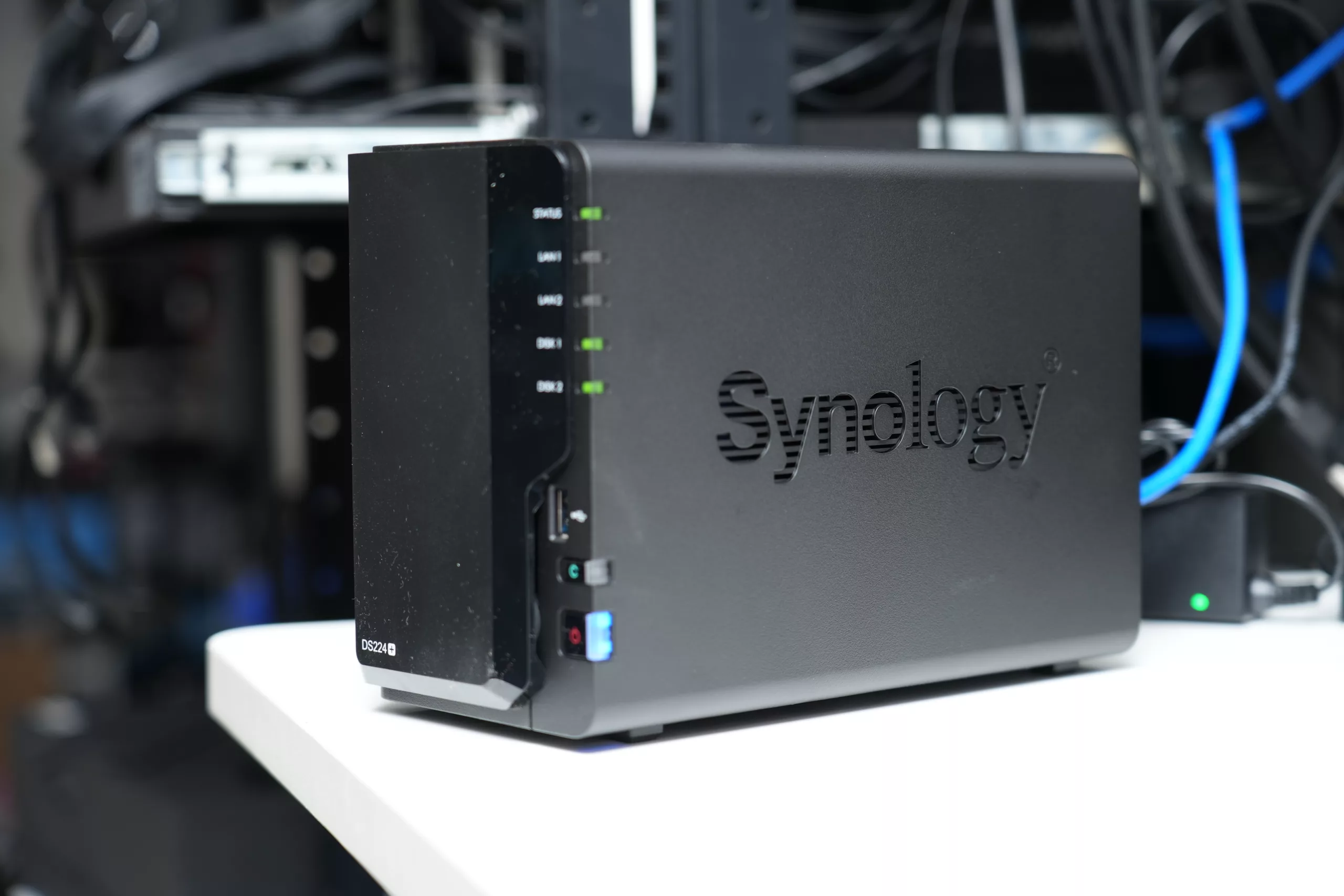Introduction
Synology’s annual refresh of most of their NAS models continues with this year’s 2-bay offering for the DS line finally getting another Plus model after a while. Featuring a quad-core Intel CPU, the new Synology DS224+ aims to provide a power efficient yet more capable 2-bay solution to very niche NAS users.
The Synology DS224+ isn’t a massive step-up from its previous Plus counterpart, still offering a similar I/O loadout and feature set as the previous model from 2020 but a CPU refresh from the same generation gives it a slight bump in performance.
Ultimately, this product is best viewed from a new buyer’s perspective rather than an upgrader so unless you have an older J-series model from the mid-2000s, the Synology DiskStation DS224+ is best for households, SMEs and small teams looking for an affordable file storage solution.
Read on to find out more about the Synology DS224+ 2-bay NAS in this review.

Features & Specification
| Specification | Details |
|---|---|
| CPU Model | Intel Celeron J4125 |
| CPU Quantity | 1 |
| CPU Core | 4 |
| CPU Architecture | 64-bit |
| CPU Frequency | 2.0 (base) / 2.7 (turbo) GHz |
| System Memory | 2 GB DDR4 non-ECC |
| Memory Slots | 1 |
| Max Memory Capacity | 6 GB (2 GB + 4 GB) |
| Drive Bays | 2 |
| Compatible Drive Type | 3.5″ SATA HDD, 2.5″ SATA SSD |
| RJ-45 1GbE LAN Port | 2 |
| USB 3.2 Gen 1 Port | 2 |
| Size (H x W x D) | 165 mm x 108 mm x 232.2 mm |
| Weight | 1.30 kg |
| System Fan | 92 mm x 92 mm x 1 pcs |
| Noise Level | 22 dB(A) |
| Power Supply Unit | 60 W |
| Power Consumption | 14.69 W (Access), 4.41 W (HDD Hibernation) |
| Operating Temperature | 0°C to 40°C |
| Warranty | 2-year, extendable to 4 years |
| Specification | Details |
|---|---|
| Maximum Single Volume Size | 108 TB |
| Maximum Internal Volume Number | 64 |
| Supported RAID Type | Synology Hybrid RAID, Basic, JBOD, RAID 0, RAID 1 |
| File Systems (Internal/External) | Btrfs, ext4 (internal); Btrfs, ext4, ext3, FAT, NTFS, HFS+, exFAT (external) |
| Maximum Concurrent Connections | 500 (expandable to 1500 with RAM expansion) |
| File Services | SMB, AFP, NFS, FTP, WebDAV, Rsync |
| Maximum Local User Accounts | 2048 |
| Maximum Local Groups | 256 |
| Maximum Shared Folder | 256 |
| Supported Protocols | SMB1 (CIFS), SMB2, SMB3, NFSv3/4/4.1, iSCSI, HTTP/s, FTP, SNMP, LDAP, CalDAV |
| Supported Browsers | Chrome, Firefox, Edge, Safari |
| Max. IP Cameras (H.264) | 25 channels, 750 FPS (720p/1080p), 350 FPS (3M), 280 FPS (5M), 170 FPS (4K) |
| Max. IP Cameras (H.265) | 25 channels, 750 FPS (720p/1080p), 600 FPS (3M), 480 FPS (5M), 200 FPS (4K) |
| Maximum Snapshots | 1,024 per Shared Folder, 65,536 System |
| Virtual Machine Manager | Recommended VM Instances: 2 |
| VPN Server | Maximum Connections: 40 |
Key Features
- 2 x 3.5/2.5″ SATA HDD/SSD Drive Bays
- 2.0 GHz Intel Celeron J4125 Quad-Core
- 2GB DDR4 RAM
- 2 x Gigabit Ethernet Ports
- 2 x USB-A 3.2 Gen 1 Ports
- RAID 0, 1, Basic, Hybrid, and JBOD
- AES-NI Hardware Encryption Engine
- 92mm Cooling Fan
- Synology DiskStation Manager OS
Official product page – Synology DS224+
Closer Look – Synology DS224+
Synology ships the DiskStation DS224+ in a brown cardboard box with a sticker label for the product. While it can be attributed to universal packaging for ecological reasons, the back of the box has a printed model of the box along with a couple of details. While few, it can be inferred that this is just Synology trying to reduce colored prints on their packaging. Those details aside, its a simple packaging that shows us the model in the colored label but the rest of the package has minimal details.
Inside the package, the Synology DiskStation DS224+ comes with a DC power brick, an AC power cable, some drive mounting screws, a pair of LAN cables and a quick installation guide.
The Synology DS224+ features the same black box design like all DiskStation tower: a simple black case with a removable front cover. The front cover isn’t the latch type we find on the 4-bays from Synology but rather a simple friction cover that slides between the front trays to lock it in place.
Fan intake passively enters thru the front spaces and is vented thru the drives via tha 92mm exhaust fans. At the rear we a single USB3.1 port along with a pair of 1GbE LAN ports. A Kensington lock notch is also at the back for security purposes.
Synology’s drive tray design hasn’t evolved much in recent years and this design is really peak on how tool-less 3.5″ tras. 2.5″ trays still need to be screwed down but otherwise, they’re perfect and easy-to-use.
As the performance offering of their 2-bay line-up, the Synology DS224+ features some step-up from the J-series. Aside from the more performant CPUs, the Synology DS224+ features support for expansion memory, with the datasheet listing official support for 4GB DDR4 SODIMM additional memory.
The drive trays support both 3.5″ and 2.5″. The larger 3.5″ drives can be secured with the rails on the side with no screws needed. For smaller SATA SSDs, you’ll need to use screws to secure the drives in place. As these need to be aligned, its highly advised that you use 4 screws to secure the drives in place so they don’t go in at an angle which may loosen over time.
 The installation sequence is simple. I highly advise using their find.synology.com service to locate your NAS once booting it up. You’ll need to setup your network and admin details before proceeding. Once done, you’ll be brought to the DiskStation Manager main screen which will serve as your home screen when working with DSM.
The installation sequence is simple. I highly advise using their find.synology.com service to locate your NAS once booting it up. You’ll need to setup your network and admin details before proceeding. Once done, you’ll be brought to the DiskStation Manager main screen which will serve as your home screen when working with DSM.
From hereon you can setup your drives with SHR or RAID1. This is where the complexity of going with a 2-bay drive makes these choices complicated. Basically, if you’re running and want the most resilient storage you can get, SHR-1 or RAID1 is your best choice as it will use both of your drives as a mirror of each other, meaning if 1 drive fails (say after 3 years or so) you can just pull out the broken drive and put a new one in. RAID1 will use the smaller size between the two drives while SHR will allow usage of the leftover space. Synology has a guide on understanding SHR at their site if you need more info.
Closer Look – System Apps
Synology’s Package Center is where you can expand the functionality of your DiskStation. At the very basic, the Synology DS224+ can serve as your file storage with network shares created with various access levels for everyone in the network but more advance usage can expand that to also serve as an NVR via the Surveillance Center, or even provide office productivity applications via their own Synology Office apps and much more.
Video Station is a good starting point if you want to build a home entertainment system on the Synology DS224+. The screenshot above shows 2 clients streaming movies off the NAS showing minimal usage leaving the NAS to do more things in the back.
Performance Testing
To test the Synology DiskStation 224+ we use two drive options: a pair of SATA SSDs and HDDs namely the T-Force Vulcan Z SATA SSD and the Seagate Ironwolf 4TB we use on all our NAS here in the lab. We test maximum performance using RAID0 and then again using RAID1. As shown earlier, the Synology DS224+ supports both SHR-1 alongside Btrfs but in the interest of keeping things uniform for comparison with other NAS, stick to RAID0/RAID1.
Those familiar will immediately see that we’re are limited by our LAN speed. Our home network is a 10Gbe network with the clients on this network all capable of at least 2.5Gbe but with that said, I’m definitely not the target for the Synology DS224+. With around 110MB/s transfer speeds, the 1GbE wire speed of the DS224+ makes it compatible with most modem/routers and their built-in switch and with Link Aggregation providing options for at least load balancing for cases wherein more than client is accessing the device. Still, you’re still limited by the 1Gbe connection so that’ something worth keeping in mind especially if you plan to use this for active applications like with Synology’s surveillance recording or real-time backup sync.
User Experience & Conclusion
A lot of power users will miss the value of a 2-bay NAS due to lack of flexibility in resilience and that’s sure to turn get some confusion in terms of recommendations if you ask about this NAS in forums or Reddit. Ultimately, this is suited for lighter use like photos, videos, small surveillance camera groups and home entertainment sharing while also serving as a shared storage space for home user. The difference is that all of this can be done on even the J-series models of the Synology DiskStation but if you plan to do all of this and host more applications on your NAS with multiple users connecting, then the DS224+ could be the better option.
If there’s something to nitpick on the Synology DS224+ is that despite its expandability, most users would be stuck on 1GbE even after years and this is a sore point for growing businesses that may not need increasing storage demands but at least be able to utilize faster networking. That said, that’s looking way into the future but as it is right now, the Synology DiskStation DS224+ is an easy-to-use NAS for households looking to have storage for their photos, videos and scale that up to video sharing and more once they familiarize themselves with the DS224+ and expand its basic offering thanks to Synology’s rich app library.
If you’ve been inkling on getting a NAS but want something a bit more power if you feel you’re going to load it up with more than just file storage, Synology is a good starting point for most users especially if you’re looking to get more punch from a small box.
The Synology DiskStation DS224+ 2-bay NAS is backed by a 2-year manufacturer warranty. I give it my B2G Recommended Award.



















